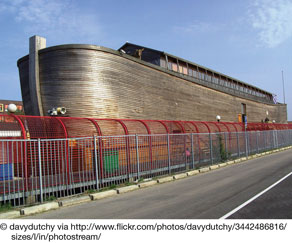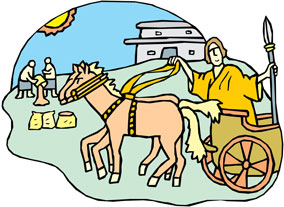

 We do not want to demean or
minimize these projects in any way, but they are classic examples of
westernizing the biblical account. As you look at this picture of this
ark replica you see a very attractive ship. The boards that make up the
ship are carefully cut, planed, and smoothed. They are fitted together
beautifully and are carefully cut and sanded to fit in an attractive
way. We have no way of knowing when the Flood occurred, but suppose we
accept the traditional date of 5,700 years ago even though 9,000 to
12,000 years ago is more reasonable. What kind of tools were available?
How was wood cut and used? Copper was used as a metal somewhere around
2,500 B.C., but smoothing, sanding, nailing and other processing of
wood was a long way off. The hundred years of work by Noah takes on a
different meaning if you realize that modern tools were not available
when he did his construction.
We do not want to demean or
minimize these projects in any way, but they are classic examples of
westernizing the biblical account. As you look at this picture of this
ark replica you see a very attractive ship. The boards that make up the
ship are carefully cut, planed, and smoothed. They are fitted together
beautifully and are carefully cut and sanded to fit in an attractive
way. We have no way of knowing when the Flood occurred, but suppose we
accept the traditional date of 5,700 years ago even though 9,000 to
12,000 years ago is more reasonable. What kind of tools were available?
How was wood cut and used? Copper was used as a metal somewhere around
2,500 B.C., but smoothing, sanding, nailing and other processing of
wood was a long way off. The hundred years of work by Noah takes on a
different meaning if you realize that modern tools were not available
when he did his construction. The problem of westernizing the biblical account comes
up in a variety of ways. We read about houses in the Bible and assume
that the dwelling places were like the ones in which we live. The fact
is that most people lived in houses with dirt floors, had no solid
doors or windows, and had a leaky roof. In Mark
2:4 when the palsied man was
lowered through a hole made in the roof, making an opening in a roof
was fairly easy to do in that day. Sweeping to find a lost coin (Luke 15:8 – 9) makes sense when you
understand how the houses were made. In Luke
11:5 – 8 we see the story of
the man who refused a traveler because he was “closed in” for the
night. The notion of just throwing open a door was not possible in the
construction of that day. All hygienic issues of cleaning and washing
in Bible times were far more complicated than most of us care to
imagine.
The problem of westernizing the biblical account comes
up in a variety of ways. We read about houses in the Bible and assume
that the dwelling places were like the ones in which we live. The fact
is that most people lived in houses with dirt floors, had no solid
doors or windows, and had a leaky roof. In Mark
2:4 when the palsied man was
lowered through a hole made in the roof, making an opening in a roof
was fairly easy to do in that day. Sweeping to find a lost coin (Luke 15:8 – 9) makes sense when you
understand how the houses were made. In Luke
11:5 – 8 we see the story of
the man who refused a traveler because he was “closed in” for the
night. The notion of just throwing open a door was not possible in the
construction of that day. All hygienic issues of cleaning and washing
in Bible times were far more complicated than most of us care to
imagine. Travel in the day of Jesus was far more laborious than
today. No one could travel from point A to point B without
adequate
preparation. Most people traveled on foot and in groups because of the
heavy crime rate on the open road. The man in the story of the good
Samaritan being beaten and robbed by thieves was all too familiar to
most people. Roads were poor and few in number, being either ruts or
Roman cobbled. The story of the Ethiopian Eunuch reading a scroll while
riding in a chariot (Acts 8:26 – 39)
shows
he
was an eager student of the Bible, studying in austere
conditions. Boats were nothing like what we are familiar with in the
Western world. Many boats were made of reeds, and some boats were more
like rafts. Jesus sleeping in the bottom of the ship in Luke 8:22 – 25 is even more
incredible when you realize what that ship was probably like.
Travel in the day of Jesus was far more laborious than
today. No one could travel from point A to point B without
adequate
preparation. Most people traveled on foot and in groups because of the
heavy crime rate on the open road. The man in the story of the good
Samaritan being beaten and robbed by thieves was all too familiar to
most people. Roads were poor and few in number, being either ruts or
Roman cobbled. The story of the Ethiopian Eunuch reading a scroll while
riding in a chariot (Acts 8:26 – 39)
shows
he
was an eager student of the Bible, studying in austere
conditions. Boats were nothing like what we are familiar with in the
Western world. Many boats were made of reeds, and some boats were more
like rafts. Jesus sleeping in the bottom of the ship in Luke 8:22 – 25 is even more
incredible when you realize what that ship was probably like. We have a very westernized view of how agriculture was
carried on in biblical times. Modern plows, cultivators, fertilizers,
and herbicides were not involved in growing crops. A hoe was a stick
with a limb on it. Sowing or planting was totally done by manual
methods. Fishing was done with nets and was very slow and labor
intensive.
We have a very westernized view of how agriculture was
carried on in biblical times. Modern plows, cultivators, fertilizers,
and herbicides were not involved in growing crops. A hoe was a stick
with a limb on it. Sowing or planting was totally done by manual
methods. Fishing was done with nets and was very slow and labor
intensive. used as a soothing help to many
illnesses (see James 5:14). Even
relatively minor injuries could be life-threatening, and death was so
common that average life expectancy in Jesus’ time was in the early
thirties.
used as a soothing help to many
illnesses (see James 5:14). Even
relatively minor injuries could be life-threatening, and death was so
common that average life expectancy in Jesus’ time was in the early
thirties.Back to Contents Does God Exist? JanFeb11.